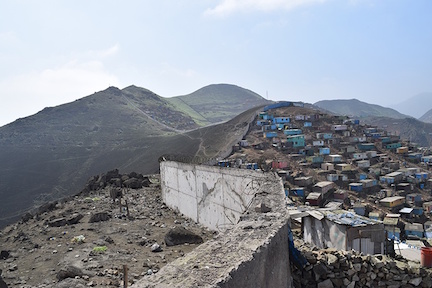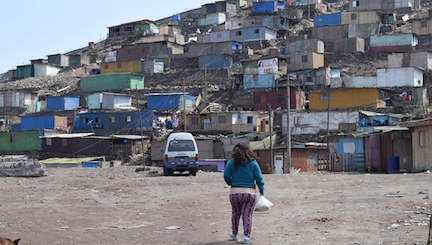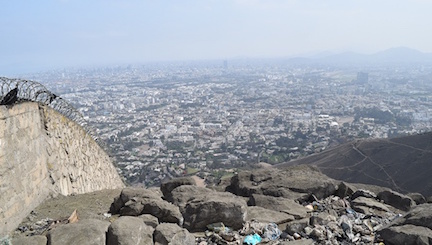The 10 kilometer-long wall separates luxury houses with large gardens and pools from makeshift homes without clean water services or electricity. Unlike other infamous barriers, the "wall of shame" does not divide nations or separate the colonized from colonizers, like the one between Israel and Palestine. It separates rich and poor people of the same country. The wall started being built in 1985 and now separates one of the wealthiest neighborhoods in the country, Casuarinas, from one of the poorest, Pamplona Alta. It was built at the request of those on the wealthy side, who say they need protection from crime committed by the poor. Pamplona Alta suffers extreme poverty, lacking most basic services. Life in the Poor Neighborhoods Mariana Natividad grew up in Pamplona Alta. Her parents took to the hills adjacent to the central districts of Lima, like millions of people who came to the capital in search of opportunities. That was over 30 years ago, when there was no wall between the poor and Casuarinas.
Mariana describes how it was back then, explaining: “I got to know the other side since I was a child. I was one of the girls that would play on the fine sands of the other side. I liked going there because it was quiet. You would go there and sit at the top and feel the breezes from the ocean. You would see a beautiful panoramic view. It was relaxing.” Indeed, from the Casuarinas side of the wall you can see all of the central neighborhoods of Lima—the wealthiest ones, most of the middle class parts, the financial district and expensive areas along the beach. You can also see the Pacific Ocean extending as far as the eye can see. But the 10-foot high and over 6-miles long "wall of shame" blocks the view now for those on the Pamplona side. It even has barbed wire on top to prevent people from climbing it. “Now you can’t even go to the top and the only thing you can do is look at this side, to the cemetery where there are dead people that remind you that one day it will be your turn,” Mariana complains. Facing a cemetery is far from the only problem in Pamplona Alta. The residents also lack clean water services, sewage, electricity, paved roads and public lighting.
Maria Lara is another resident of Pamplona Alta. She explains that because of the lack of well-built structures, in the winter residents have to cover their houses with big plastic sheets to help prevent the cold and humid weather from penetrating inside. Maria also described a common occurrence in the area. Because they use candles to see at night and “because fathers and mothers work long hours and they leave their children alone at home at night,” Maria explained, there are often fires. "One of my children suffered an accident," she said. "He dropped a candle and his little hand caught on fire.” One of the common complaints about the daily life of people of Pamplona is getting water. Private companies bring drinking water on trucks as far as the road goes and then people have to carry it further up the hill to their homes. The companies sell the water at a higher price than what public services charge. Life on the Wealthy Side Casuarinas is one of the wealthiest neighborhoods in all of Peru, with houses that cost more than US$5 million. From the top of the hill where the Wall of Shame sits, one can see scores of green areas and pools. All public roads are paved, well lighted and clean. Most houses have electric fences, security cameras and private security personnel, with security posts all along the wall.
Even though the roads that go through Casuarinas are public, there are checkpoints at the entrances to keep non-residents out. Besides guests of the rich, some of those who allowed in are workers who perform all types of services for the residents of Casuarinas, such as gardeners, cooks, cleaners, nannies and guards. Many of those who work in Casuarinas are from Pamplona Alta, but they cannot cut across the hills to come to work because of the wall. They must go down the hill on the Pamplona side and take a road that goes around it. The trip takes close to an hour on public transportation. Mariana does not like to imagine working on the Casuarinas side. "What can possibly happen when you go to their homes? If they marginalize you from here at a distance, how could it be when you are close? They probably dislike coming into contact with you by mistake," she said. How the Wall of Shame Was Built According to an article published by La República newspaper, the first part of the Wall of Shame was built in 1985 by Jesuits who own a prestigious primary and secondary school, The Immaculate, attended by the children of Peru's elite. The Jesuits were worried about the alleged threat to their students posed by people from Pamplona. Other residents of Casuarinas were worried about a drop in the price of their real estate due to the proximity to Pamplona. In the early 1990s, people from different settlements of Pamplona Alta protested against the construction of the wall and their leaders such as Luis Pacheco and Juan Almeida, were arrested or tried under accusations of acts of violence to stop the construction. The last part of the Wall of Shame was built in 2013 and it separates eight settlements from Casuarinas, including the one where Mariana lives. She recalls that, at the time, “100 police officers came to support the construction. Unfortunately, when they come like that we cannot do anything ... Unfortunately, we who are on the bottom cannot fight against those on top.” Inequality in Peru When asked about the inequality between the physically divided neighborhoods, Mariana says, "They are the same people like us, the only difference is that they are more developed. They have all that money to spend on building that ‘Wall of Shame’ instead of spending it on good things, like places such as this that really need it.” She ends her answer by saying, “dreaming doesn’t cost anything but when you wake up, you see this reality and I live here. What can I do?” Peru is one of the most unequal countries on the planet, with 25 percent of its citizens suffering from monetary poverty and 37 percent suffering from what's called multidimensional poverty, according to CEPAL. Multidimensional poverty is precisely what one sees in Pamplona Alta with the lack of access to good health care, education and water services. Furthermore, 43 percent of Peruvian children under 3 years of age suffer from anemia due to poverty. At the same time, the wealth of the top 515 richest Peruvian accounts for 3 percent of the national GDP and represents 10 times what the state invests in education every year. The poorest members of society would have to work for 326 years just to make as much as one month of income of those in the top groups. While Peru experienced a high rate of growth in the last 20 years due to high prices of minerals, the gains were far from equally distributed. Between 2013 and 2014, the GDP of Peru grew 2.35 percent, but the wealth of the rich increased by 9.6 percent. That wealth could go toward eliminating poverty. Instead, the wealthy are addressing the "threat" of the poor by building walls to keep them out. Source URL |



